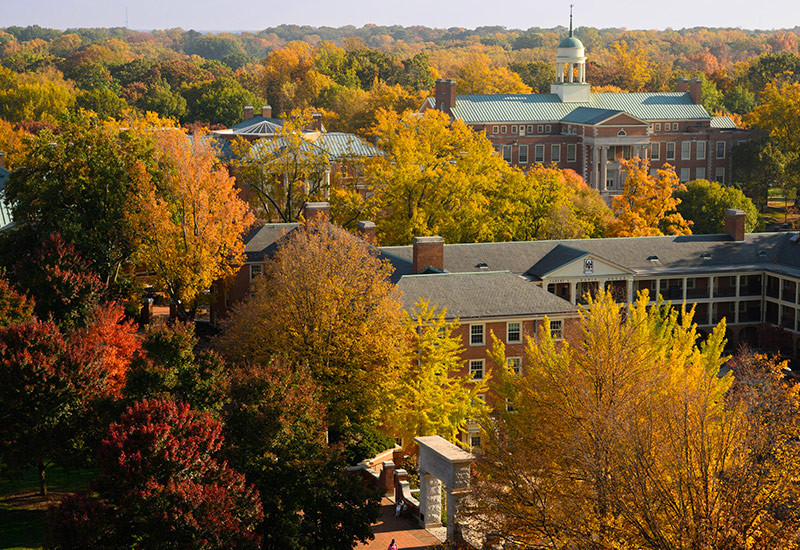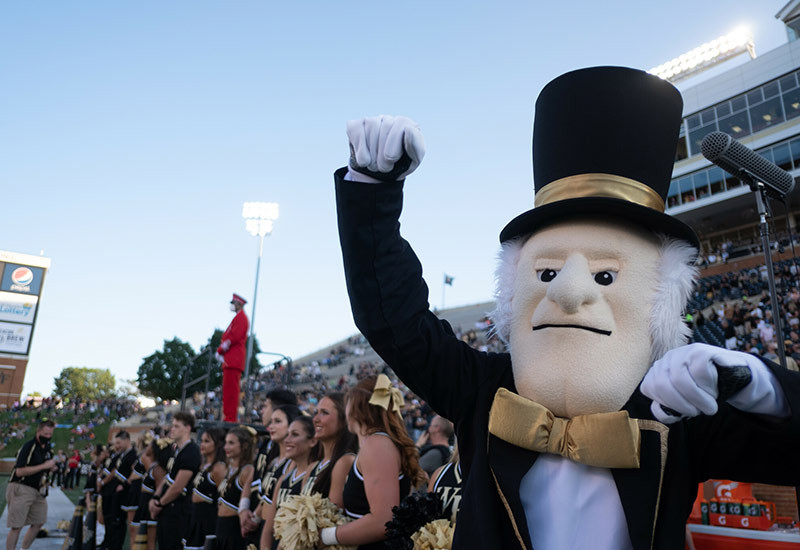Wake Forest University, a distinguished institution known for its commitment to academic excellence and the principle of Pro Humanitate, attracts students from across the globe. If you’re wondering, Where Is Wake Forest University?, it’s nestled in the vibrant city of Winston-Salem, North Carolina. However, the story of Wake Forest’s location is richer than just its current address, involving a historical move that shaped its identity.
 Wake Forest University campus in the fall.
Wake Forest University campus in the fall.
Unpacking Wake Forest University’s Location: A Detailed Look
Winston-Salem, North Carolina: The University’s Home
Wake Forest University’s primary campus is situated in Winston-Salem, a city in Forsyth County, North Carolina. This location provides a blend of a serene campus environment with access to the cultural and urban amenities of a thriving city. Winston-Salem, often referred to as the “Twin City” due to its historical dual identity of Winston and Salem, boasts a rich history in tobacco and furniture industries, now evolving into a hub for arts, healthcare, and technology.
The university’s address is easily accessible and well-known within Winston-Salem, contributing to the city’s identity and economy. Being located in North Carolina, Wake Forest benefits from the state’s growing reputation in education and research, placing it within a dynamic and progressive region of the United States.
From Wake Forest to Winston-Salem: A Historical Relocation
Interestingly, the name “Wake Forest” hints at the university’s original location. Founded in 1834, Wake Forest University was initially established in the town of Wake Forest, North Carolina, just north of the state capital, Raleigh. It was known then as the Wake Forest Manual Labor Institute, reflecting its early focus on combining education with practical skills.
However, in 1956, Wake Forest College made a significant move to Winston-Salem. This relocation was a pivotal moment in the university’s history, marking its transition from a smaller college town setting to a more expansive and resource-rich urban environment. The move to Winston-Salem provided Wake Forest with opportunities for growth, development, and broader engagement with a larger community. Despite the move, the university retained its original name, a nod to its roots and history in Wake Forest, NC.
Campus Overview in Winston-Salem
The Wake Forest University campus in Winston-Salem spans 340 acres, offering a picturesque setting with Georgian-style architecture, lush green spaces, and advanced facilities. The Reynolda Campus, as it is primarily known, houses the undergraduate programs as well as several graduate schools.
Key features of the campus include:
- Wait Chapel: A central landmark, hosting significant university events and ceremonies.
- Reynolda Gardens: Adjacent to the campus, offering beautiful gardens and trails for students and visitors.
- State-of-the-art academic buildings: Equipped with modern technology and designed to foster collaborative learning.
- Athletic facilities: Home to the Demon Deacons, including the Lawrence Joel Veterans Memorial Coliseum and Truist Field at Wake Forest.
 The Wake Forest Campus Life office holds its Wake Up Wednesday event during Mental Health Week.
The Wake Forest Campus Life office holds its Wake Up Wednesday event during Mental Health Week.
Who is Wake Forest University For? Understanding the Community
Wake Forest University is a private institution that welcomes a diverse and ambitious student body. In Fall 2024, the university enrolled over 9,300 students, with a significant undergraduate population of nearly 5,500 and a substantial graduate student body of over 3,800. This includes students from all 50 U.S. states, Puerto Rico, Washington D.C., and 38 foreign countries, creating a globally diverse learning environment.
The university prides itself on its inclusive community, with a commitment to ethnic diversity, representing 38% of the student body. The gender distribution is also noteworthy, with a slightly higher percentage of female students (57%) compared to male students (43%).
Wake Forest’s faculty and staff community is substantial, contributing to a rich academic and support network. With over 2,700 faculty members and more than 5,300 staff, the university ensures a low student-to-faculty ratio of 11:1, allowing for personalized attention and mentorship opportunities.
 Fall 2023 U.S. Undergraduate enrollment map
Fall 2023 U.S. Undergraduate enrollment map
Academics and Learning at Wake Forest
Wake Forest University offers a comprehensive range of academic programs across its various schools and colleges. Undergraduate students can choose from 49 majors and over 60 minors, spanning disciplines from humanities and sciences to business and fine arts. Graduate programs are equally diverse, offered through the university’s esteemed colleges and schools, including the School of Business, School of Law, School of Medicine, and Graduate School of Arts and Sciences.
The university emphasizes small class sizes, with 99% of undergraduate classes having fewer than 50 students, fostering an interactive and engaging learning environment. This focus on personalized education contributes to impressive career outcomes, with 97% of graduates being employed or enrolled in graduate school within nine months of graduation. Furthermore, Wake Forest encourages global engagement, with 60% of undergraduates participating in study abroad programs, broadening their perspectives and experiences.
 Students present their research at the Undergraduate Research Day.
Students present their research at the Undergraduate Research Day.
Athletics and the Demon Deacons
For those interested in sports, Wake Forest University is a prominent NCAA Division I institution, competing in the Football Bowl Subdivision. As a member of the Atlantic Coast Conference (ACC), the Demon Deacons are well-recognized in collegiate athletics. The university fields 18 varsity teams, with 9 for men and 9 for women, and has secured 10 NCAA Championships.
The mascot, the Demon Deacon, is a unique and spirited symbol of Wake Forest athletics, embodying the university’s energetic and competitive spirit. Beyond competition, Wake Forest prioritizes academic success for its athletes, boasting a student-athlete graduation rate of 96%, as measured by the NCAA.
 Demon Deacon mascot at a Wake Forest football game.
Demon Deacon mascot at a Wake Forest football game.
Wake Forest Alumni: A Global Network
Wake Forest University’s impact extends far beyond its campus in Winston-Salem, through its extensive network of over 82,000 living degree recipients. These alumni are spread across 50 U.S. states and 103 foreign countries, demonstrating the university’s global reach and influence. While a significant portion of alumni (38%) call North Carolina home, the network spans diverse geographical locations and professional fields.
Notable alumni include figures like Richard Burr, Tim Duncan, and Chris Paul, showcasing the wide-ranging achievements of Wake Forest graduates in politics, sports, and various other sectors.
 Demon Deacon logo
Demon Deacon logo
Leadership, Character, and Pro Humanitate at Wake Forest
Wake Forest University is deeply rooted in its motto, Pro Humanitate, meaning “For Humanity.” This principle is not just a motto but a guiding philosophy that permeates the university’s academic, community service, and leadership development initiatives. The Program for Leadership and Character exemplifies this commitment, aiming to cultivate leaders who are not only skilled but also ethical and dedicated to serving humanity.
The university also places a strong emphasis on career-focused outcomes, providing students with resources and support through the Office of Personal and Career Development. This commitment ensures that Wake Forest graduates are well-prepared to navigate their career paths and make meaningful contributions to society.
Conclusion: Discover Wake Forest in Winston-Salem
So, to definitively answer the question, Wake Forest University is located in Winston-Salem, North Carolina. Its location offers a rich blend of academic rigor, vibrant campus life, and access to a dynamic city. From its historical roots in Wake Forest, NC, to its present-day home in Winston-Salem, the university continues to uphold its values of Pro Humanitate, leadership, and academic excellence. Whether you are a prospective student, a curious inquirer, or an alumnus, exploring Wake Forest University means discovering a place with a strong sense of community, a commitment to global impact, and a rich history in the heart of North Carolina.
For more information, explore the official Wake Forest University website and discover all that this exceptional institution has to offer.
